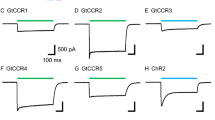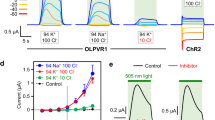Abstract
The hyperpolarizing receptor potential in vertebrate rod photo-receptors appears to be mediated by the second messenger, cyclic GMP. Injection of cGMP into rods1,2 or application of cGMP to inside-out membrane patches3 activates a conductance resembling that produced by light. Light produces a rapid reduction of cGMP in living rods4, leading to closure of sodium channels and membrane hyperpolarization. In most invertebrate photoreceptors the response to light is depolarizing. We have investigated whether cGMP is involved in controlling the increase in sodium conductance that underlies this depolarization5. We show here that injection of cGMP into Limulus photoreceptors produces a depolarization that mimics the receptor potential. We also show that the cGMP concentration of the squid retina increases rapidly during exposure to light. These results support the hypothesis that cGMP mediates the light-induced depolarization in invertebrate photoreceptors and suggests that vertebrate and invertebrate phototransduction may be more similar than previously thought.
This is a preview of subscription content, access via your institution
Access options
Subscribe to this journal
Receive 51 print issues and online access
$199.00 per year
only $3.90 per issue
Buy this article
- Purchase on Springer Link
- Instant access to full article PDF
Prices may be subject to local taxes which are calculated during checkout
Similar content being viewed by others
References
Miller, W. H. & Nichol, G. D. Nature 280, 64–66 (1979).
MacLeish, P. R., Schwartz, E. A. & Tachibana, M. J. Physiol. Lond. 348, 645–664 (1984).
Fesenko, E., Kolesnikov, S. S. & Lyubarsky, A. Nature 313, 310–313 (1985).
Woodruff, M. L., Bownds, D., Green, S. H., Morrisey, J. L. & Shedlovski, A. J. gen. Physiol. 69, 667–679 (1977).
Millechia, R. & Mauro, A. J. gen. Physiol. 54, 331–351 (1969).
Fuortes, M. G. F. & Yeandle, S. J. gen. Physiol. 47, 443–463 (1964).
Brown, J. E. et al. Nature 311, 160–163 (1984).
Fein, A., Payne, R., Corson, D. W., Berridge, M. J. & Irvine, R. F. Nature 311, 157–160 (1984).
Fein, A. & Corson, D. W. Science 204, 77–79 (1979).
Payne, R., Corson, D. W., Fein, A. & Berridge, M. J. J. gen. Physiol. 88, 127–142 (1986).
Calman, B. & Chamberlain, S. J. J. gen. Physiol. 80, 839–862 (1982).
Stern, J., Chinn, K., Bacigalupo, J. & Lisman, J. J. gen. Physiol. 80, 825–837 (1982).
Stern, J. & J. Proc. natn. Acad. Sci. U.S.A. 79, 7580–7584 (1982).
Robinson, P. R., Radeke, M. J., Cote, R. H. & Bownds, M. D. J. biol. Chem. 261, 313–318 (1986).
Zimmerman, A. L., Yamanaka, G., Eckstein, F., Baylor, D. A. & Stryer, L. Proc. natn. Acad. Sci. U.S.A. 82, 8813–8817 (1985).
Saibil, H. FEBS Lett. 168, 213–216 (1984).
Corson, D. W. & Fain, A., Biophys. J. 44, 299–304 (1983).
Lisman, J. E. & Brown, J. E. J. gen. Physiol. 66, 489–506 (1975).
Steiner, A. L. Meth. Enzym. 38, 96–112 (1974).
Bitensky, M. W., German, R. E. & Miller, W. H. Proc. natn. Acad. Sci. U.S.A. 68, 561–526 (1971).
Payne, R., Corson, D. W. & Fein, A. J. gen. Physiol. 88, 107–126 (1986).
Author information
Authors and Affiliations
Rights and permissions
About this article
Cite this article
Johnson, E., Robinson, P. & Lisman, J. Cyclic GMP is involved in the excitation of invertebrate photoreceptors. Nature 324, 468–470 (1986). https://doi.org/10.1038/324468a0
Received:
Accepted:
Issue Date:
DOI: https://doi.org/10.1038/324468a0
This article is cited by
-
The ordered visual transduction complex of the squid photoreceptor membrane
Molecular Neurobiology (1999)
-
Current issues in invertebrate phototransduction
Molecular Neurobiology (1997)
-
Cyclic 3?, 5?-nucleotide phosphodiesterase: cytochemical localization in photoreceptor cells of the flyCalliphora erythrocephala
Journal of Neurocytology (1993)
Comments
By submitting a comment you agree to abide by our Terms and Community Guidelines. If you find something abusive or that does not comply with our terms or guidelines please flag it as inappropriate.



